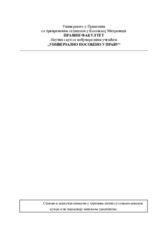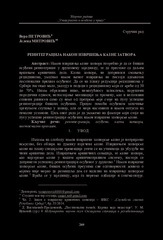Приказ основних података о документу
Reintegracija nakon izvršenja zatvorske kazne
Reintegration after serving prison sentence
| dc.creator | Petrović, Vera | |
| dc.creator | Mitrović, Jelena | |
| dc.date.accessioned | 2021-06-17T13:52:14Z | |
| dc.date.available | 2021-06-17T13:52:14Z | |
| dc.date.issued | 2018 | |
| dc.identifier.isbn | 978-86-6083-054-0 | |
| dc.identifier.uri | http://rfasper.fasper.bg.ac.rs/handle/123456789/3004 | |
| dc.description.abstract | Након извршења казне затвора потребно је да се бивши осуђени реинтегрише у друштвену заједницу, те да престане са даљим вршењем кривичних дела. Казна затвора, не доприноси смањењу рецидивизма, уколико након њеног извршења не постоји адекватан постпенални прихват осуђеног. Да се на плану редукције рецидивизма у Србији постиже мало, указују и подаци о рецидивизму који се креће од 50 до 70%. Низак образовни ниво, немогућност запослења, нарушени породични односи, непостојање мотивације за промену, као и негативни ставови јавности само су неке од препрека које стоје на путу успешне реинтеграције бивших осуђених. Процес помоћи осуђеном започиње тренутком ступања у затвор, али се мора наставити и након отпуста из пеналне установе. Циљ овог рада је да укажемо на факторе који стоје на путу успешне реинтеграције осуђених након извршене затворске казне. | |
| dc.description.abstract | After serving a prison sentence, it is necessary for the former convict to be reintegrated into the community and to cease further crime committing. Prison sentence does not contribute to recidivism reduction if an adequate post-penalty acceptance of the convict does not exist. The fact that the recidivism rate fluctuates between 50 and 70% of cases indicates that little is achieved in recidivism risk plan in Serbia. Low educational levels, inability to find employment, deteriorated family relationships, lack of motivation to change as well as the public’s negative attitude are just a few of the obstacles found on the way of successful reintegration of former convicts. The process of assisting the convict begins in the moment of them entering the prison; however, it needs to continue after the leave from the correction facility. The aim of this paper is to emphasize the factors restricting a successful reintegration of the convicts after serving prison sentence | |
| dc.publisher | Правни факултет Универзитета у Приштини са привременим седиштем у Косовској Митровици | |
| dc.rights | openAccess | |
| dc.rights.uri | https://creativecommons.org/licenses/by-sa/4.0/ | |
| dc.source | Zbornik radova Naučnog skupa sa međunarodnim učešćem 'Univerzalno i osobeno u pravu“ | |
| dc.source | Зборник радова „Универзално и особено у праву“ | |
| dc.subject | реинтеграција | |
| dc.subject | осуђени | |
| dc.subject | казна затвора | |
| dc.subject | постпенални прихват | |
| dc.subject | reintegration | |
| dc.subject | convicts | |
| dc.subject | prison sentence | |
| dc.subject | post-penalty acceptance | |
| dc.title | Reintegracija nakon izvršenja zatvorske kazne | sr |
| dc.title | Reintegration after serving prison sentence | |
| dc.type | conferenceObject | |
| dc.rights.license | BY-SA | |
| dc.citation.epage | 285 | |
| dc.citation.other | : 269-285 | |
| dc.citation.spage | 269 | |
| dc.description.other | Univerzalno i osobeno u pravu | |
| dc.identifier.fulltext | http://rfasper.fasper.bg.ac.rs/bitstream/id/8862/bitstream_8862.pdf | |
| dc.identifier.fulltext | http://rfasper.fasper.bg.ac.rs/bitstream/id/8861/bitstream_8861.pdf | |
| dc.identifier.rcub | https://hdl.handle.net/21.15107/rcub_rfasper_3004 | |
| dc.type.version | publishedVersion |



